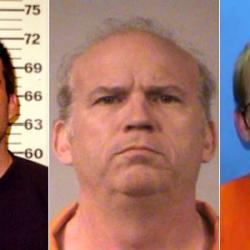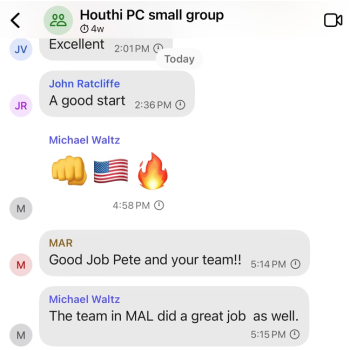I’ve posted this story before, but it was some 10 years ago (!) — see “Preached down to four,” which I’m copying from here — so I think it’s fair game to revisit it now. After all, I first heard this story from Tony Campolo, and he repeats it far more often than once a decade. Tony got the story from Clarence Jordan, founder of Koinonia Farms and thus, later, of Habitat for Humanity.
In the 1950s, an old “hillbilly preacher” invited Jordan to come and speak at his church in rural South Carolina. Jordan arrived to find, to his surprise, a large, thriving and racially integrated congregation — a remarkable thing in that time and place. (Sadly, it’s actually a remarkable thing in any time or place.) So Clarence asked the man how this came about.
When he first got there as a substitute preacher, the old man said, it was a small, all-white congregation of a few dozen families. So he gave a sermon on the bit from Galatians where Paul writes: “You are all children of God … There is neither Jew nor Greek, slave nor free, male nor female, for you are all one in Christ Jesus.”
Here I’ll pick up from Tony Campolo’s retelling of Jordan’s story:
“When the service was over, the deacons took me in the back room and they told me they didn’t want to hear that kind of preaching no more.”
Clarence asked, “What did you do then?”
The old preacher answered, “I fired them deacons!”
“How come they didn’t fire you?” asked Clarence.
“Well, they never hired me,” the old preacher responded. … “Once I found out what bothered them people, I preached the same message every Sunday. It didn’t take much time before I had that church preached down to four.”
Tony and Jordan told that story as an illustration, generally, of the principle that the preaching congregations need to hear is often the very preaching that those congregations don’t want to hear. And they both told it, more specifically, to point out that what most white congregations don’t want but very much need to hear is preaching that condemns white supremacy. They both held up the success of this “hillbilly preacher” as an example of the kind of church growth and fruit-bearing ministry that can come about only if churches are willing to tackle “what bothered them” — i.e., the sin of white supremacy — head on.
That’s all very biblical stuff. Very Isaiah 58 — loose the bonds of injustice, break every chain and set free the oppressed and “Then your light shall break forth like the dawn, and your healing shall spring up quickly … and you shall be like a watered garden, like a spring of water, whose waters never fail. Your ancient ruins shall be rebuilt; you shall raise up the foundations of many generations; you shall be called the repairer of the breach, the restorer of streets to live in.”
I like to think that’s all true — that good moral advice will also be good practical advice for church leaders seeking to have growing, thriving congregations. Alas, I’m not entirely hopeful that it always works out so neatly. Sometimes, as in the case of this hillbilly preacher’s success, doing the right thing will lead to greater success. Other times, I’m afraid, virtue will need to be its own reward because it will be its only reward.
In any case, I’m reminded of this story because Clarence Jordan and Tony Campolo are both, like me, Baptists. And so is Louie Gohmert and so is Andrew Gardner, who writes about people like Gohmert for Baptist News, “What should pastors do if their members helped incite the Capitol riots?”
Many reflections on evangelicalism’s relationship to the current Republican Party and Donald Trump think in the abstract about this group’s evolution.
Such abstractions do not shed light on how to lead a congregation when a member of the diaconate, for instance, incited violence or stormed the U.S. Capitol. …
Gardner avoids abstraction here by focusing on one specific example, that of Rep. Louis Gohmert, a long-time member and deacon at Green Acres Baptist Church. Gardner, Gohmert, and Green Acres have some history in thinking about these things, going back to Gohmert’s ugly remarks following the mass-shooting in an Aurora, Colorado, movie theater in 2012:
I wrote a piece challenging Gohmert’s rhetoric as unfitting for both a Christian and his office.
In the course of writing the piece, I discovered that Gohmert publicly states on his congressional website (and still does to this day) that he is a longtime member, deacon and Sunday school teacher at Green Acres Baptist Church in Tyler, Texas. … I sent a cordial email to his pastor, David Dykes, expressing my sadness over Gohmert’s statements and a link to my blog post.
To my surprise, Dykes responded. He thanked me for my email and expressed his gratitude that we both live in a country where we can express our differences of opinion. Rather than defend Gohmert’s comments, Dykes defended Gohmert as a “brother in Christ” whom he had known “for the past 22 years.” He wrote, “I feel like the French guide at the Louvre who heard an American tourist criticizing some of the classic art. He said, ‘The paintings here are no longer under scrutiny; only the critics.’”
That’s quite the analogy. St. Louie Gohmert, his pastor says, is the Mona Lisa of Christianity, and anyone who would question his piety is an ugly American tourist. Wow. The audacity of that claim is as arrogantly weird as the fact that the same guy making it simultaneously regards himself and his powerful congregation as a persecuted minority of “real Americans” beleaguered by the oppression of suspiciously French elites.

Anyway, that was back in 2012 and the prions gobbling Louie Gohmert’s brain have been very busy over the ensuing years, leading up to his current, ongoing support for the Big Lie that incited the January 6 insurrection — an attack on the Constitution and on democracy itself that Gohmert is still reluctant to condemn.
Gardner writes:
Gohmert’s statements and the events of Jan. 6 are not likely to result in any spiritual recourse for Gohmert at Green Acres Baptist Church, but I wonder how things would be different if that were a possibility. Pastors certainly have a lot to deal with on a daily basis. Policing their congregants is likely not something they wish to add to their already busy lives — and where would one draw the line anyway?
Abstract and subtle or even not-so-subtle hints buried in the Sunday sermon likely do little aside from encourage pastors to assume they have done their due diligence. Silence from the pulpit, however, also breeds complicity. For instance, by not making a statement, Green Acres Baptist Church essentially condoned Gohmert’s rhetoric as perfectly acceptable behavior for a member of their congregation.
The possibility of losing members is another glaring obstacle. As congregations continue to face membership decline, publicly and even privately calling members out for their behavior could threaten the budget. In so doing, this could threaten ministries and even a pastor’s job, depending upon congregational politics.
Gardner never quite manages to answer the question posed in the title of his piece: “What should pastors do?” He reaches back for historical examples, discussing the ways 19th century church leaders hoped that seminaries would help to “police” unacceptable behavior in congregations, and he somewhat lukewarmly considers earlier forms of “bans” and “excommunications” in Baptist congregations.
That’s the sort of thing that other denominations turn to in what they would regard as matters of “church discipline.” But, again, we’re talking about Baptists here. We Baptists don’t do that. We don’t do “church discipline” because we’re not a church and we can’t “excommunicate” anybody because we never communicated anybody to begin with.
Which brings us back to Clarence Jordan’s old friend, the hillbilly preacher, and his approach to exactly this situation: “Once I found out what bothered them people, I preached the same message every Sunday.” No need to kick anybody out, just preach what bothers them — preach what they need to hear — until they either repent or choose to leave on their own.
I don’t know if that always or even usually works. But it’s a very, very Baptist approach.












